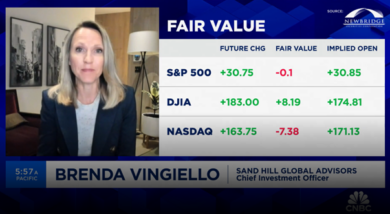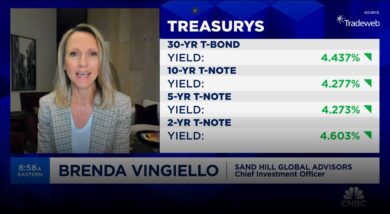Sand Hill's Chief Investment Officer, Brenda Vingiello, CFA, joins Jenny Harrington on “Halftime Report” to go over their most recent portfolio moves. Brenda's commentary begins

A Turbulent Ride
The last six months have been a turbulent time in the financial market as we endured the two most extreme return quarters for the S&P 500 since the financial crisis. If you are asking yourself, “What happened?!”, you’re not alone. Few experts predicted a year of negative stock market returns in 2018 given the favorable fundamental backdrop. Even those who did get it right likely would not have properly timed getting back into the market in the midst of the longest U.S. government shutdown in history, economic data softening and volatility during this period.
While staying invested, and sensibly rebalancing along the way, can be an emotionally difficult task, many studies have shown that it is nearly impossible to time the market. In a study performed by J.P. Morgan, it was determined that, if the ten best days were missed over the course of a 20-year investment period, annualized returns would have been half of that of a portfolio that was fully invested during the whole period. Furthermore, the best and worst days tend to cluster together, so even if you were to miss the ten worst days, the likelihood of catching the best days is very low.
For those with a longer time horizon, staying the course and having the fortitude to act in a contrarian manner has proven to be advantageous and has been the mantra of many famous investors including Warren Buffett, who lives by his famous quote, “Buy when there is blood in the streets, even if it is your own,” which he has clearly proved over a long period.
So what sparked the precipitous drop that caused many to doubt the longevity of this economic cycle? During the second half of last year, economic data began to soften globally but was still quite robust in the U.S. In fact, quite a bit of good news was released during the fourth quarter – from third quarter corporate earnings to employment data. However, it was largely ignored as investors worried that growth in the U.S. would eventually be impacted by trends abroad and that a monetary policy mistake had a high likelihood of leading to an abrupt end to the economic cycle. While interest rates were still low relative to historical levels, the Federal Reserve had raised rates nine times since 2015 and was also reducing the size of its balance sheet. This combination of tightening and unraveling economic stimulus simultaneously was essentially unchartered territory for the Federal Reserve and, with the benefit of hindsight, had caused financial conditions to tighten too much and was contributing to economic slowing. The stock market fell nearly 20% from its high before finally bottoming on Christmas Eve. Despite the dire media rhetoric and ongoing pressure from tax-loss harvesting sales, we felt that economic data was not suggesting a recession was imminent. Furthermore, with a relatively new chair of the Federal Reserve in place, communication was clunky and the message being sent was that developments within the global economy were being taken into consideration. Given the fundamental disconnect, we added when the stock market had fallen to a level where we felt a case for a compelling return could be made.
As the fourth quarter came to a close and the government shutdown persisted, economic data became more mixed in the U.S. By this time, the U.S. Federal Reserve, along with central banks around the world, had become much more dovish with the Federal Reserve itself signaling a “patient” approach to 2019 rate hikes. It was also becoming clearer that the economy was slowing, but not poised for a recession in the near term, particularly given the renewed support of central banks. This resulted in a swift stock market rally in January that might have been missed by market-timers. In fact, the majority of the 7%+ return happened on just four individual days. It was following this rally that we reduced exposure to the stock market, essentially removing the exposure that was added during the fourth quarter, as valuation had become less attractive.
As the quarter wore on, fourth quarter earnings were reported and companies gave what appeared to be conservative guidance for the first quarter. Globally, economic data began to look like it had bottomed as financial conditions were loosening and central banks’ stimulus efforts were beginning to have a positive impact. The biggest news came from the Federal Reserve during the FOMC’s March meeting when an official end to the previously planned balance sheet reduction effort was announced. This allayed fears of monetary policy throwing a wrench into the economic cycle. The stock market rallied in response and the yield curve briefly inverted in mid-March when 3-month Treasury bonds were yielding more than 10-year Treasury bonds. This inversion lasted for five days but still received a lot of media attention as the last several recessions were preceded by a yield curve inversion. For the time being, economic data is improving which in our view suggests a recession isn’t imminent but, only time will tell if it will be a reliable indicator during this cycle.
As we assess the environment today, there is no denying that we are in the 11th year of this economic cycle. With unprecedented levels of central bank support, it is possible the global economy could stage a nice recovery here, particularly if we get more clarity on global trade in the coming months and if a Brexit path is finally agreed upon. However, we also have to question just how long this level of central bank support can go on and whether or not the global economy will be able to stand on its own two feet. We have taken the tactic of trading around extreme moments in the market while also maintaining a relatively low level of risk in portfolios, and plan to continue this disciplined approach. One benefit of the Federal Reserve having raised rates nine times is that very short-term bonds are now yielding close to 3% and we have favored these near risk-free investments in your portfolio as they should help buffer extreme market moments in the future.
While market turbulence can be unsettling, it is an inherent part of investing. Having a team to help navigate the ever-changing environment on your behalf is an important step in achieving financial goals and we look forward to continuing this effort in both good times and bad.
Source: “Get Invested, Stay Invested: Navigating Volatile Markets.” JP Morgan Asset Management 09 November 2018.
Articles and Commentary
Information provided in written articles are for informational purposes only and should not be considered investment advice. There is a risk of loss from investments in securities, including the risk of loss of principal. The information contained herein reflects Sand Hill Global Advisors' (“SHGA”) views as of the date of publication. Such views are subject to change at any time without notice due to changes in market or economic conditions and may not necessarily come to pass. SHGA does not provide tax or legal advice. To the extent that any material herein concerns tax or legal matters, such information is not intended to be solely relied upon nor used for the purpose of making tax and/or legal decisions without first seeking independent advice from a tax and/or legal professional. SHGA has obtained the information provided herein from various third party sources believed to be reliable but such information is not guaranteed. Certain links in this site connect to other websites maintained by third parties over whom SHGA has no control. SHGA makes no representations as to the accuracy or any other aspect of information contained in other Web Sites. Any forward looking statements or forecasts are based on assumptions and actual results are expected to vary from any such statements or forecasts. No reliance should be placed on any such statements or forecasts when making any investment decision. SHGA is not responsible for the consequences of any decisions or actions taken as a result of information provided in this presentation and does not warrant or guarantee the accuracy or completeness of this information. No part of this material may be (i) copied, photocopied, or duplicated in any form, by any means, or (ii) redistributed without the prior written consent of SHGA.
Video Presentations
All video presentations discuss certain investment products and/or securities and are being provided for informational purposes only, and should not be considered, and is not, investment, financial planning, tax or legal advice; nor is it a recommendation to buy or sell any securities. Investing in securities involves varying degrees of risk, and there can be no assurance that any specific investment will be profitable or suitable for a particular client’s financial situation or risk tolerance. Past performance is not a guarantee of future returns. Individual performance results will vary. The opinions expressed in the video reflect Sand Hill Global Advisor’s (“SHGA”) or Brenda Vingiello’s (as applicable) views as of the date of the video. Such views are subject to change at any point without notice. Any comments, opinions, or recommendations made by any host or other guest not affiliated with SHGA in this video do not necessarily reflect the views of SHGA, and non-SHGA persons appearing in this video do not fall under the supervisory purview of SHGA. You should not treat any opinion expressed by SHGA or Ms. Vingiello as a specific inducement to make a particular investment or follow a particular strategy, but only as an expression of general opinion. Nothing presented herein is or is intended to constitute investment advice, and no investment decision should be made based solely on any information provided on this video. There is a risk of loss from an investment in securities, including the risk of loss of principal. Neither SHGA nor Ms. Vingiello guarantees any specific outcome or profit. Any forward-looking statements or forecasts contained in the video are based on assumptions and actual results may vary from any such statements or forecasts. SHGA or one of its employees may have a position in the securities discussed and may purchase or sell such securities from time to time. Some of the information in this video has been obtained from third party sources. While SHGA believes such third-party information is reliable, SHGA does not guarantee its accuracy, timeliness or completeness. SHGA encourages you to consult with a professional financial advisor prior to making any investment decision.
Other Posts By This Author
- – CNBC Halftime: Portfolio Moves | March 14, 2024
- – CNBC Squawk Box: Market Trends | March 6, 2024
- – CNBC Squawk Box: CPI Report | February 13, 2024
- – Getting Back to Normal
Related Posts







